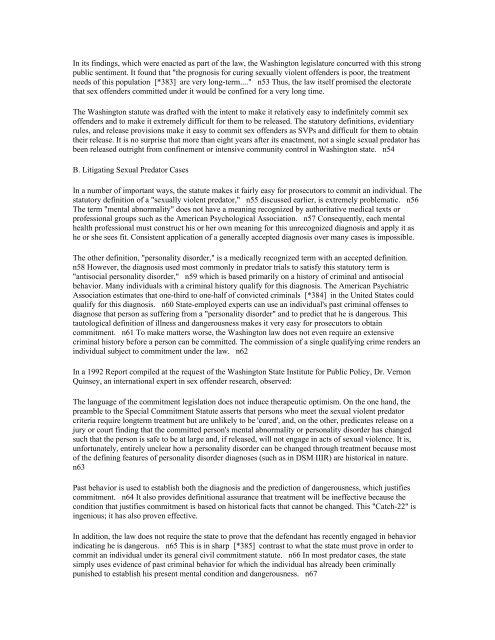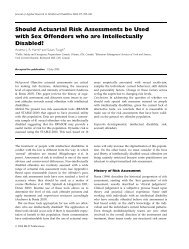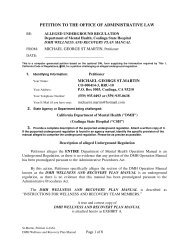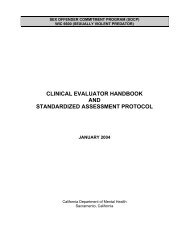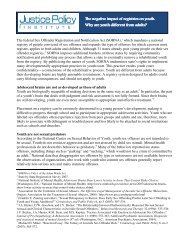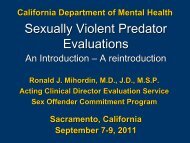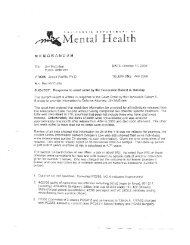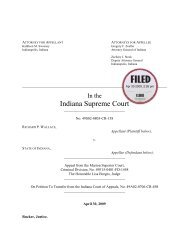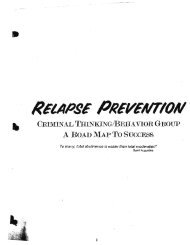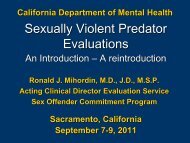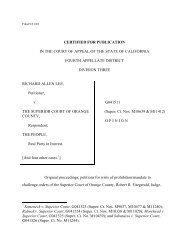Therapeutic Jurisp & Sexual Predator Laws - Defense for SVP
Therapeutic Jurisp & Sexual Predator Laws - Defense for SVP
Therapeutic Jurisp & Sexual Predator Laws - Defense for SVP
You also want an ePaper? Increase the reach of your titles
YUMPU automatically turns print PDFs into web optimized ePapers that Google loves.
In its findings, which were enacted as part of the law, the Washington legislature concurred with this strongpublic sentiment. It found that "the prognosis <strong>for</strong> curing sexually violent offenders is poor, the treatmentneeds of this population [*383] are very long-term...." n53 Thus, the law itself promised the electoratethat sex offenders committed under it would be confined <strong>for</strong> a very long time.The Washington statute was drafted with the intent to make it relatively easy to indefinitely commit sexoffenders and to make it extremely difficult <strong>for</strong> them to be released. The statutory definitions, evidentiaryrules, and release provisions make it easy to commit sex offenders as <strong>SVP</strong>s and difficult <strong>for</strong> them to obtaintheir release. It is no surprise that more than eight years after its enactment, not a single sexual predator hasbeen released outright from confinement or intensive community control in Washington state. n54B. Litigating <strong>Sexual</strong> <strong>Predator</strong> CasesIn a number of important ways, the statute makes it fairly easy <strong>for</strong> prosecutors to commit an individual. Thestatutory definition of a "sexually violent predator," n55 discussed earlier, is extremely problematic. n56The term "mental abnormality" does not have a meaning recognized by authoritative medical texts orprofessional groups such as the American Psychological Association. n57 Consequently, each mentalhealth professional must construct his or her own meaning <strong>for</strong> this unrecognized diagnosis and apply it ashe or she sees fit. Consistent application of a generally accepted diagnosis over many cases is impossible.The other definition, "personality disorder," is a medically recognized term with an accepted definition.n58 However, the diagnosis used most commonly in predator trials to satisfy this statutory term is"antisocial personality disorder," n59 which is based primarily on a history of criminal and antisocialbehavior. Many individuals with a criminal history qualify <strong>for</strong> this diagnosis. The American PsychiatricAssociation estimates that one-third to one-half of convicted criminals [*384] in the United States couldqualify <strong>for</strong> this diagnosis. n60 State-employed experts can use an individual's past criminal offenses todiagnose that person as suffering from a "personality disorder" and to predict that he is dangerous. Thistautological definition of illness and dangerousness makes it very easy <strong>for</strong> prosecutors to obtaincommitment. n61 To make matters worse, the Washington law does not even require an extensivecriminal history be<strong>for</strong>e a person can be committed. The commission of a single qualifying crime renders anindividual subject to commitment under the law. n62In a 1992 Report compiled at the request of the Washington State Institute <strong>for</strong> Public Policy, Dr. VernonQuinsey, an international expert in sex offender research, observed:The language of the commitment legislation does not induce therapeutic optimism. On the one hand, thepreamble to the Special Commitment Statute asserts that persons who meet the sexual violent predatorcriteria require longterm treatment but are unlikely to be 'cured', and, on the other, predicates release on ajury or court finding that the committed person's mental abnormality or personality disorder has changedsuch that the person is safe to be at large and, if released, will not engage in acts of sexual violence. It is,un<strong>for</strong>tunately, entirely unclear how a personality disorder can be changed through treatment because mostof the defining features of personality disorder diagnoses (such as in DSM IIIR) are historical in nature.n63Past behavior is used to establish both the diagnosis and the prediction of dangerousness, which justifiescommitment. n64 It also provides definitional assurance that treatment will be ineffective because thecondition that justifies commitment is based on historical facts that cannot be changed. This "Catch-22" isingenious; it has also proven effective.In addition, the law does not require the state to prove that the defendant has recently engaged in behaviorindicating he is dangerous. n65 This is in sharp [*385] contrast to what the state must prove in order tocommit an individual under its general civil commitment statute. n66 In most predator cases, the statesimply uses evidence of past criminal behavior <strong>for</strong> which the individual has already been criminallypunished to establish his present mental condition and dangerousness. n67


